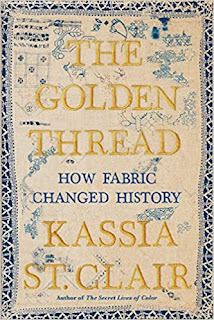The Golden Thread
 The Golden Thread: How Fabric Changed History, by Kassia St. Clair
The Golden Thread: How Fabric Changed History, by Kassia St. ClairA while ago, St. Clair's first book, The Secret Lives of Color, was very popular, but I had already read Victoria Finlay's Color: A Natural History of the Palette (which is wonderful, and apparently I read it pre-Howling Frog, which surprises me!) and I -- rather snobbily -- eschewed the newer book, thinking it couldn't be as good. I will have to rethink that snap judgement. I can never resist a book about textiles, and though I kind of thought this might be on the light side, I found that I enjoyed it very much and and recommend it to any textile-lover...or for that matter, anybody who has never given a thought to the huge importance of textiles.
This book is not a comprehensive history of the development of early textiles, though. St. Clair hops around a bit in the fields of history and geography. Each chapter focuses on one sub-topic, and gives several stories about that. So there is no giant history of linen (that might take a very large book); there is a chapter on linen's importance in ancient Egypt, and several different stories about that.
After weaving and linen, there are chapters on silk, wool, cotton, lace, and then more modern fabrics such as rayon, textiles for extreme cold, space suits, sports, and, finally, spider silk. Each one contains fascinating stories and details.
One of my favorite stories was about the work of Su Hui, who composed and embroidered an incredibly complex poem, Star Gauge, on a panel of silk. It can be read in any direction and is divided into panels, as shown:
 |
| Su Hui and her poem |
And as I mentioned, there is a lot of information here about modern developments in fabrics, too. The chapter on cold-weather gear was particularly fascinating, involving both mountain-climbing and polar exploration. Early cold-weather gear was ridiculously difficult and inadequate, being mostly wool. Alpinists were ...snobbish? ignorant? about the extreme environment, and so we get descriptions like
By 1924 Mallory had grudgingly accepted the need for gaseous aid to climb Everest. Even today many climbers believe climbing without it is aesthetically preferable; previously Mallory had believed that it was unsporting and, worse, un-British.
[on the first man to try out down clothing, coated in balloon fabric] Finch, an Australian, was ridiculed by the snobbish Alpine Club and his contemporaries refused to adopt the style, even when it proved far warmer than their own gear.This book was so much fun! I loved reading it. In fact, since last week was National Library Week, we decided to celebrate by taking 'quarantine shelfies,' and I chose to use The Golden Thread as my book.





This sounds so interesting -- I love social history and books about how everyday things influence society. It's amazing how something so seemingly mundane can make such a difference. For example, yesterday I learned that the Germans lost the Battle of Stalingrad because they parked their tanks outside the city and rats chewed through the electric wiring. I had no idea.
ReplyDeleteExcellent find! I, too, love this sort of social history book. I have one about the history of knitting that I should excavate from the shelves and read!
ReplyDeleteI became excited for a moment until I realized that I had mistaken The Golden Thread for The Golden Bough, lol! Sounds like an interesting book though.
ReplyDeleteOh my goodness! I had rats chew through my electrical wiring in my car! I can't believe they were doing it back then, little rotters! You'd think someone would have though of a remedy by now. I suspect the rats might be smarter than we are!
Rats are definitely smarter than we are. I had no idea about that in Stalingrad, though, Karen, I want to know more!
ReplyDeleteCleo, would you be up for a Golden Bough readalong? I have tried a couple of times but I tend to get bogged down. I could really use some reminders!
You know me and my read-alongs!l I'm always up for them. However, I have The Mysteries of Udolpho I'm reading with Fancied Freedom this summer and The Decameron with Reese possibly in September. Would you consider doing a slower read of it? That way I should be able to fit it in. However, I know you like to read faster so if that doesn't work just let me know. I hope we can figure something out.
ReplyDeleteI'll PM you on Goodreads!
ReplyDeleteThis sounds really good! I'm going to see if I can find it. I used to sew and knit a lot, and I think my mom would enjoy reading it, too.
ReplyDeleteThis sounds really good! I did read her first book, mainly because I went to a bookshop on the last day of a vacation in London and felt like buying things and it was sooooo prettyyyyyy with all the colors, and I liked it a lot. It didn't feel so much like it was trying to be a comprehensive history of color, but more almost like a blog or an essay series that focused on color. Which was neat! And it sounds like this is along similar lines?
ReplyDeleteYes! A series of essays describes it well. And I do agree about the very pretty cover!
ReplyDelete